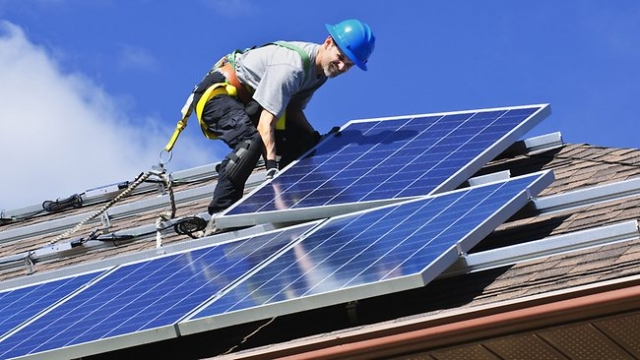
It all means that the guidelines we provide in this article need to be approached with considerable caution, allowing for your own local and household circumstances.
How many solar panels are you likely to need?
A solar panel can generally be expected to produce about 10 watts per square foot, equating to a panel conversion efficiency of around 12%. This means you’ll need approximately 100 square feet of solar panels for every kW you generate.
Now, if the sun shone on a 24-hours-a-day basis, you could install 100 sq ft of solar panels and would already be generating sufficient energy to power the average U.S. home. But we’re sure you won’t need us to tell you that your premises are only exposed to the sun during daylight hours, and even then, the amount of cloud cover will affect how much sunlight you can expect. That’s before you also consider that the number of daylight hours varies by the season.
While there are online resources out there that can assist you in figuring out how many hours of sunlight you can expect in your own neighborhood on average each day, there are nonetheless some rough guidelines you can follow. Such areas as Pittsburgh, Seattle, and Chicago often only see about three hours of sunlight a day, whereas states like California and Colorado are more accustomed to around five or six hours, and you might get as many as seven hours of sunshine in Arizona.
This can make quite a big difference to the size of the panel array you’ll need. 400 sq. ft. of panels delivering around 4 kW may suffice, or you might want to go for an 800 sq. ft. panel array giving you about 8 kW. The less sunshine you get in your area each day, the more solar panels you’ll require, whereas if you already receive a lot of sunshine in your locality, you can lower the panel count.
So, what real difference is likely to be made to your bills?
This is where we get down to the details of whether solar panels are actually likely to benefit your finances much, and initial reading may not be overly encouraging. Right now, solar panels cost about $7 to $9 per watt to install, so if you’re interested in a 5 kW system, you’re looking at a price of around $25,000 to $35,000. It might also take literally decades for your system to pay for itself.
There is good news, however. Incentives are on offer from many utility providers, which may slash as much as 50% off the system costs. You may even be able to find a program in your area that gives you Earned Income Tax Credits (EITCs) when you have solar panels installed in your home. If you manage to cover a large proportion of your installation costs through the use of subsidies and rebates, you might be able to start achieving real savings a lot sooner than you think.
One program that we spotted enabled qualifying homeowners to lease or buy solar panels for little to $0 down. Such a policy can make a massive difference, given the tens of thousands of dollars that you might otherwise need to pay – perhaps with the help of a high-interest rate loan – to be able to take advantage of solar panels.
By drawing upon the various discounts and sources of support out there, you may be able to reduce your installation and auxiliary equipment costs to as little as around $1 per watt. That means you may only need to spend about $10,000 for a 5 kW system, which would then have a payback period of only ten years or so, whether or not you can obtain subsidies.
The relevance of solar panels is only increasing
We’ll leave you with a few positive takeaways. First of all, solar panels are becoming progressively more affordable, with companies like AVA Solar, Nanosolar and First Solar having introduced thin-film panels to the residential market. All the while, we can’t expect electric rates to stay the same as they are now. They will probably creep up, along with fuel and other infrastructure costs, which will help to make solar panels even more relevant through reduced payback periods.
In short – yes, you can expect to save potentially thousands by going solar, and the benefits are only likely to increase as the years wear on. It means there can simply be no better a time to invest in solar panels than right now.
Disclaimer: Our service is not intended to be, nor should it be construed as financial advice. We help our readers make informed decisions via impartial information and guides. Where appropriate, we may introduce partner companies who can provide services relating to financial products.